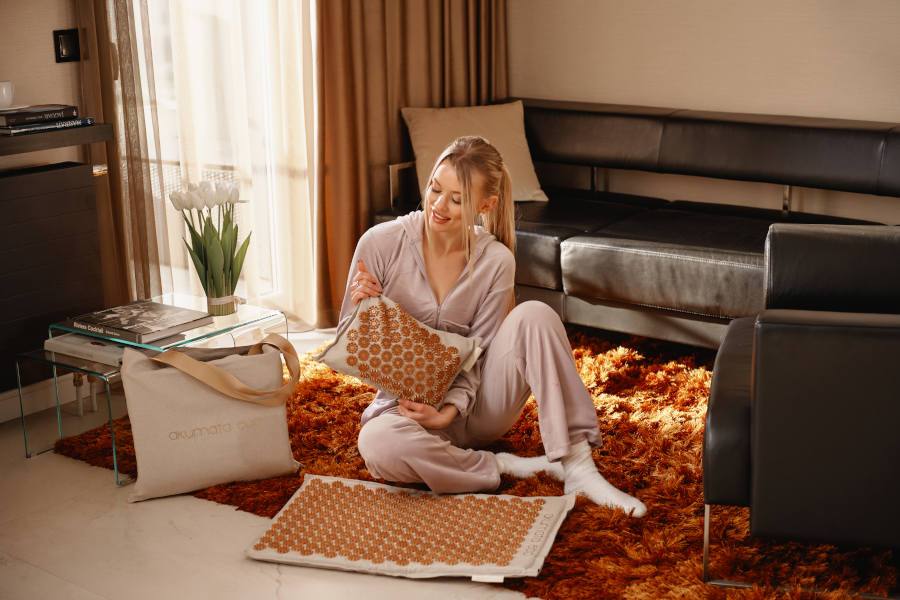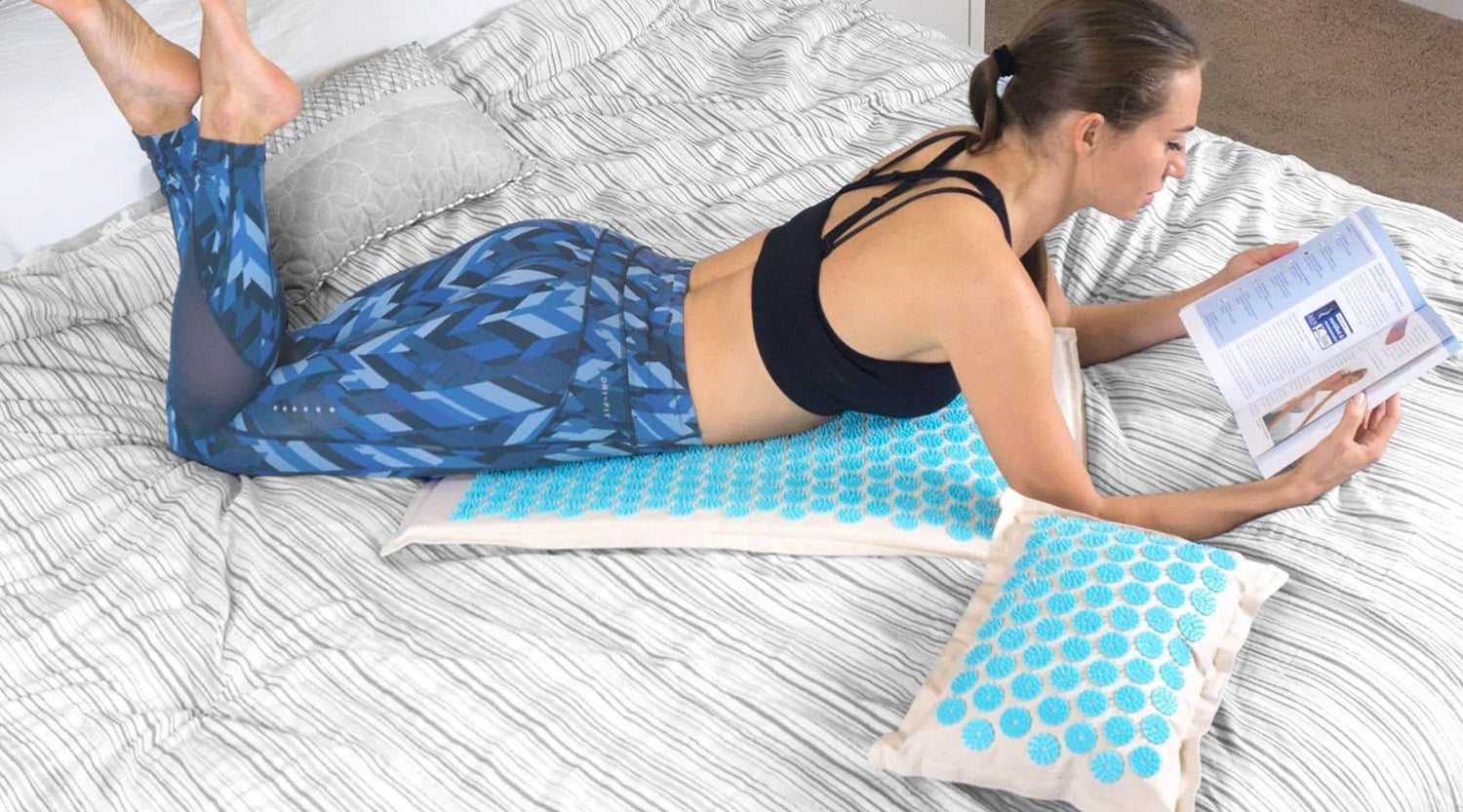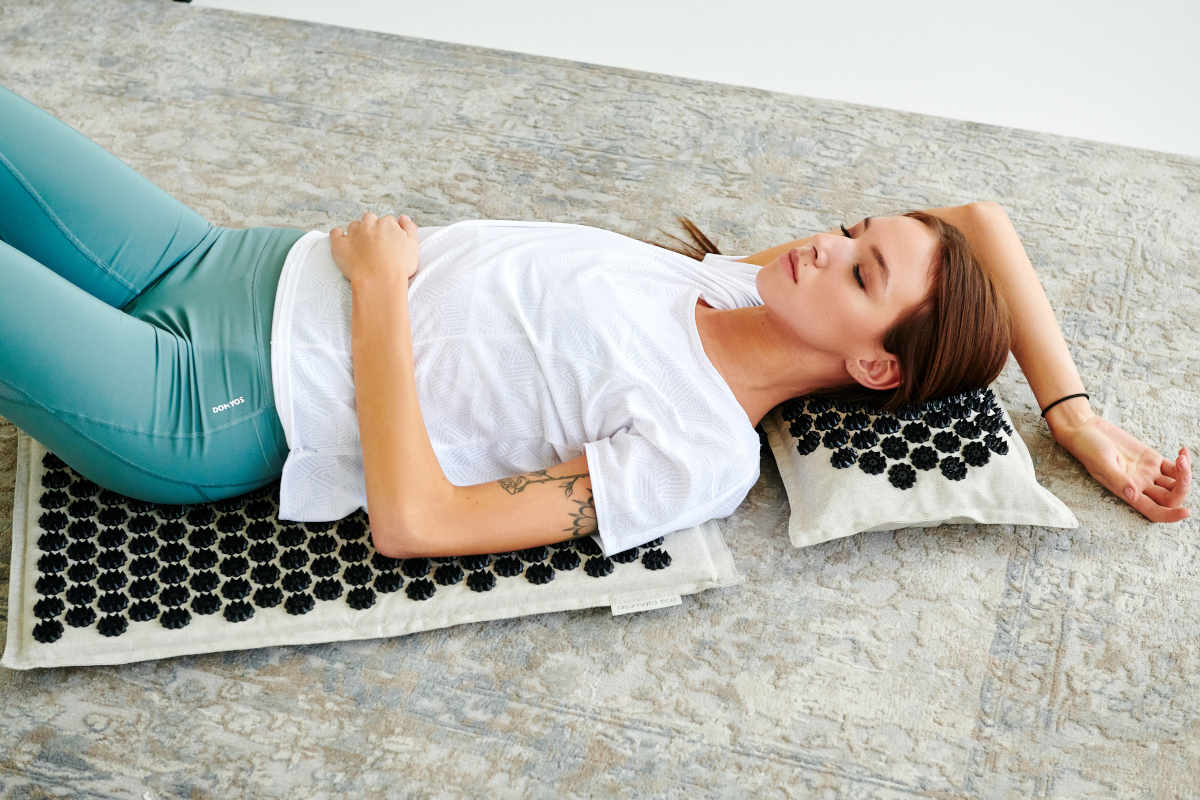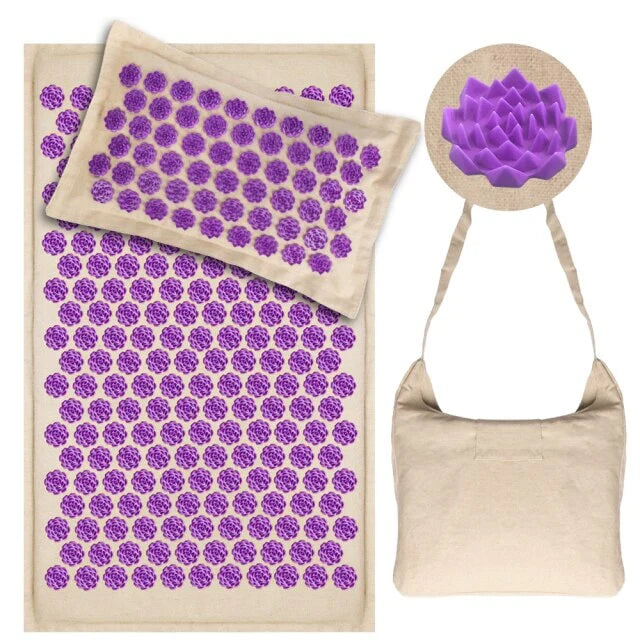What is an acupressure mat and how does it work?

Definition and design
An acupressure mat is a therapeutic tool designed with numerous small, plastic spikes to stimulate specific acupressure points on the body. Inspired by ancient Chinese practices, these mats aim to mimic the effects of acupuncture by applying pressure without the use of needles. The mat is often accompanied by a neck pillow for additional relief of tension in the neck and shoulders.
These mats are covered with spikes that, when in contact with the skin, stimulate pressure points, promoting increased blood flow, relaxation, and pain relief. Many people use a complete acupressure mat set, which includes a mat and pillow, to enhance the benefits of their therapy sessions.
Theory behind acupressure mats
The concept of acupressure mats is grounded in Traditional Chinese Medicine and the theory of meridians. By applying pressure to specific acupressure points, these mats aim to unblock energy pathways and boost circulation. This theory is similar to acupuncture, where needles are used to stimulate these points.
However, acupressure mats offer a non-invasive alternative that can be used daily for relaxation and wellness. Although scientific evidence is still limited, user feedback often highlights positive effects like stress relief, decreased muscle tension, and improved mental clarity.
Benefits and effectiveness of using acupressure mats

Pain relief and muscle tension
Acupressure mats are popular for providing relief from chronic pain and muscle tension. When you lie on the mat, the spikes apply pressure to acupressure points, which increases blood flow and stimulates nerve endings.
This pressure may decrease pain signals and boost the body’s natural pain-relief mechanisms. A study published in Acupuncture in Medicine suggests that acupressure may help manage shoulder pain and lower back pain, making it a valuable complement to other medical treatments.
Stress relief and improved sleep
Using an acupressure mat is an effective way to relax and fall asleep more easily. The gentle pressure from the spikes helps relieve pain and tension, allowing the body to shift into a more relaxed state. Regular use can improve overall wellness and reduce symptoms of stress.
According to clinical practice reports, many users have experienced better sleep quality after incorporating acupressure mats into their daily routine. This relaxation training method works by stimulating pressure points that activate the parasympathetic nervous system, promoting calmness and mental relaxation.
How to use an acupressure mat effectively?

Practical tips for beginners
When getting started with an acupressure mat, it’s important to take gradual steps. For beginners, it’s best to start with a short 5-10 minute session while wearing a thin shirt to lessen the intensity of the spikes. Over time, you can increase the duration and adjust the level of skin contact to achieve deeper pressure.
If using the mat for chronic pain in the back or shoulders, consider lying flat or using a neck pillow. Product details such as the size of the mat and the material of the spikes can also influence comfort and effectiveness, so it’s worth choosing a mat that fits your needs.
Using acupressure mats for specific conditions
Acupressure mats can be particularly beneficial for targeting specific conditions such as shoulder pain, neck tension, and stress-related headaches. For example, using a yoga acupressure mat can be a great way to combine physical activity with relaxation.
Additionally, acupressure mats are sometimes called a "bed of nails" due to their design, which stimulates acupressure points across a large surface area. This design allows users to treat multiple areas of the body at once, offering a holistic approach to pain management.
Safety and potential risks of acupressure mats

Precautions and safety guidelines
Although acupressure mats are generally safe, there are precautions to consider. Individuals with heart conditions, open wounds, or recent injuries should consult with a doctor before using a mat.
Pregnant women should avoid lying on the mat for long periods, as stimulating certain pressure points could inadvertently trigger labor. When selecting an acupressure mat, details material such as the firmness of the spikes and the quality of the mat and pillow set are crucial for safe and effective use.
Potential side effects and when to avoid use
Common side effects of acupressure mats include temporary redness, bruising, and light discomfort. While these effects are usually mild, those with sensitive skin or certain physical concerns should exercise caution.
A Cochrane review on the effectiveness of acupressure indicated that while most people experience only minor side effects, those with severe medical conditions should be particularly careful.
Beyond traditional uses of acupressure mats

Modern applications and technological advancements
Recent advancements in acupressure technology have led to the development of acupressure massage devices and heated mats. These new products aim to enhance the health benefits of traditional mats by incorporating features like heat therapy, which is known to boost blood circulation and relieve muscle tension.
Additionally, innovations such as the Shakti mat and AcupressureMat® are designed with eco-friendly materials, making them a sustainable choice for health-conscious consumers. These developments expand the traditional concept of acupressure while offering more customizable options.
Combining acupressure mats with other therapies
Acupressure mats can be combined with other alternative therapies like reflexology, meditation, and aromatherapy. This combination can intensify relaxation and enhance the effectiveness of pain management.
For instance, incorporating essential oils while using the mat can create a soothing atmosphere, helping to relieve tension and ease trouble falling asleep. Feedback from users suggests that combining therapies provides a well-rounded approach to wellness and self-care.
Conclusion

Acupressure mats offer a convenient, non-invasive way to manage pain, reduce stress, and enhance overall well-being. While the effectiveness of acupuncture is well-documented, these mats provide a similar experience without the use of needles.
Though scientific evidence on their effectiveness is still evolving, many users find acupressure mats beneficial for promoting relaxation, improving sleep, and relieving muscle tension. By understanding how to use them correctly and exploring modern applications, individuals can integrate acupressure mats into their self-care routines to support their physical and mental health.
Frequently askes questions

1. Do acupressure mats really work?
Yes, acupressure mats can be effective for relieving pain and promoting relaxation. These mats work by stimulating specific pressure points, similar to the principles of traditional acupuncture but without using needles. When used regularly, acupressure mats can boost energy, improve blood flow, and alleviate pain.
Many users have reported experiencing relief from conditions such as back pain and tension headaches. However, it's worth noting that while user claims are positive, the mats are intended to complement other therapies rather than replace them.
2. What are the benefits of using an acupressure mat?
Acupressure mats offer a range of benefits, including pain relief, reduced stress, and improved sleep quality. By stimulating pressure points, the mats help increase circulation and release endorphins, the body’s natural painkillers.
The benefits of acupressure extend to alleviating muscle soreness, lowering blood pressure, and boosting relaxation. When used as part of an acupressure and acupuncture massage set, these mats provide a convenient way to experience the benefits of acupuncture without invasive procedures.
3. How do acupressure mats relieve pain?
Acupressure mats help alleviate pain by applying pressure to key points on the body. This technique mimics acupuncture treatments and stimulates the release of pain-relieving hormones. The gentle pressure promotes relaxation and improves blood flow, which can help manage muscle tension, chronic pain, and post-injury recovery.
While not a substitute for professional healthcare, these mats are a valuable addition to at-home acupressure therapy routines. Experts often recommend using these mats to enhance physical recovery and well-being.
4. Can acupressure mats help with sleep issues?
Yes, acupressure mats can be helpful for those experiencing trouble falling asleep or staying asleep. The mats are designed to stimulate relaxation and promote relaxation by applying pressure to acupressure points associated with stress relief.
By using an acupressure mat and pillow set before bed, users can ease tension and prepare their body and mind for rest. Research claims that regular use can lead to improved sleep quality over a few weeks, making it an effective tool for acupressure for symptom management.
5. Are acupressure mats safe to use every day?
Generally, acupressure mats are safe for daily use, but it’s essential to be mindful of your body's reactions. For those with pre-existing concerns like sensitive skin or severe injuries, it’s advisable to consult a healthcare expert first.
For beginners, start with short sessions (5-10 minutes) and gradually extend the time as you get used to the bare pressure from the spikes. Clinical reports suggest that consistent use can effectively manage stress and pain, but balance and caution are crucial.
6. Can acupressure mats help reduce stress?
Acupressure mats are well-regarded for their ability to promote relaxation and reduce stress. By applying gentle pressure to key acupressure points, these mats can lower cortisol levels and calm the nervous system.
Users have reported feeling more relaxed and centered after each session. Combining the use of these mats with other relaxation techniques, like meditation or breathing exercises, can boost their effectiveness and provide a comprehensive stress relief strategy.
7. How long should you lie on an acupressure mat?
The recommended duration depends on your experience level and comfort. Beginners can start with 5-10 minute sessions and gradually extend to 20-30 minutes. It’s best to listen to your body and adjust the time accordingly.
Those seeking specific benefits, such as pain relief acupressure or relaxation, can experiment with different durations and positions. Acupressure mats should be seen as a flexible tool that adapts to individual needs, enhancing overall health.
8. Can acupressure mats help with weight loss?
While acupressure mats are not a direct solution for weight loss, they can promote relaxation and reduce stress, which may indirectly support weight management efforts. Stress and poor sleep are linked to weight gain, and using an acupressure mat can help alleviate these factors.
Combined with a balanced diet and regular exercise, the mats contribute to a holistic approach to weight management. They are often part of an acupressure and acupuncture regimen aimed at promoting overall wellness.
9. How do I choose the best acupressure mat for my needs?
When choosing an acupressure mat, consider factors like price, material, and the size of the mat. Some mats come in complete acupressure mat and pillow sets for comprehensive use. If you’re looking for deeper pressure, select a mat covered with longer spikes, but if you prefer softer pressure, opt for mats with more rounded points.
Reading product details and jump to reviews from verified buyers can help you make an informed decision. It's important to find a mat that matches your comfort level and health goals.
10. Is there scientific evidence supporting the use of acupressure mats?
While there is limited scientific evidence, some studies indicate that acupressure mats can provide relief for various symptoms, including pain and stress. Research in clinical practice has shown that stimulating pressure points with these mats can improve blood flow and lower blood pressure in certain cases.
Although more evidence is needed to confirm long-term benefits, the growing popularity of acupressure mats and positive feedback from users highlight their potential as a complementary therapy for at-home symptom management.








